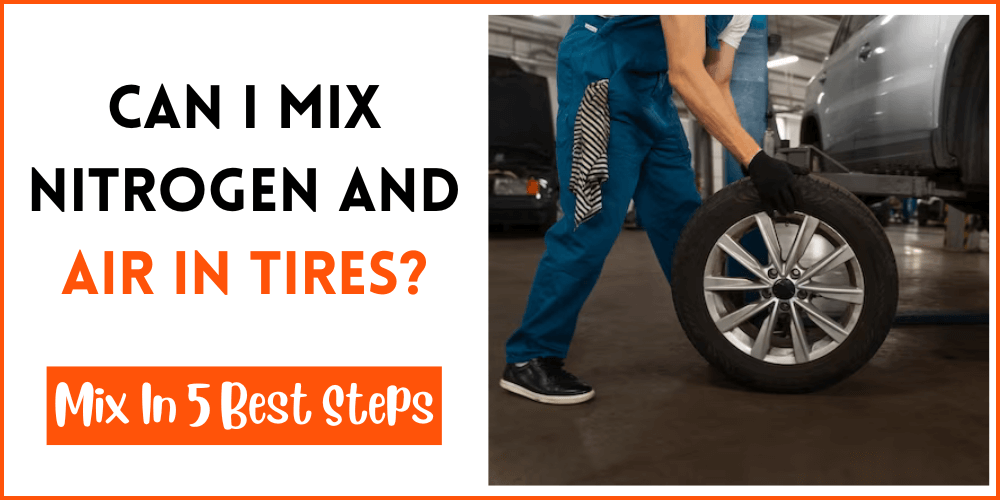

When it comes to tire inflation, many drivers have wondered if it’s possible to mix nitrogen and air in their tires. Can I mix nitrogen and air in tires? In this article, we’ll explore the benefits of nitrogen in tires, the potential risks of mixing nitrogen and air, how to mix them, and the science behind it.
Can I Mix Nitrogen And Air In Tires?
To understand Can I mix nitrogen and air in tires? Using nitrogen in tires offers several advantages over regular air inflation. Here are some key benefits:
- Improved Tire Pressure Stability: Nitrogen molecules are larger and less likely to escape through the tire’s rubber compared to oxygen molecules. This results in better pressure retention and more consistent tire performance.
- Reduced Tire Aging and Deterioration: Nitrogen is a dry gas that doesn’t contain moisture. Which can cause oxidation and damage to the tire’s inner structure. By reducing moisture, nitrogen helps slow down tire aging and prolongs its lifespan.
- Enhanced Fuel Efficiency: Inflated tires contribute to better fuel efficiency. Nitrogen-filled tires maintain optimal tire pressure longer. Also, it reduces rolling resistance and improves fuel economy.
- Consistent Tire Performance: Nitrogen-filled tires provide more stable and predictable performance. Especially in extreme temperatures. This is particularly beneficial for drivers who need precise handling and braking control.
Potential Risks Of Mixing Nitrogen And Air
While it’s possible to mix nitrogen and air in tires, it’s not recommended due to potential risks. So, Can I mix nitrogen and air in tires, Here are a few reasons why mixing these two gases can be problematic:
- Compromised Tire Pressure Stability: Mixing nitrogen and air can result in inconsistent tire pressure. The different gases have varying expansion and contraction rates with temperature changes.
- Increased Risk of Tire Failure: Inadequate tire pressure can lead to tire failure. It reduced traction and compromised safety on the road. Mixing nitrogen and air can compromise the stability and reliability of your tires.
- Reduced Benefits of Nitrogen: Mixing air with nitrogen dilutes the nitrogen’s benefits. Such as improved pressure retention and reduced moisture. It diminishes the advantages that pure nitrogen inflation provides.
How To Properly Mix Nitrogen And Air In Tires
If you decide to mix nitrogen and air in your tires, it’s important to follow these guidelines for safe and effective mixing:
- Start with properly inflated tires using nitrogen.
- Use a reliable tire pressure gauge to measure the tire pressure.
- Release a small amount of nitrogen from each tire.
- Refill the tires with compressed air, ensuring the recommended tire pressure is achieved.
- Regularly check the tire pressure to maintain optimal levels.
It’s worth noting that many tire experts recommend sticking with pure nitrogen inflation for the best results.
The Science Behind It
Nitrogen and air differ in their composition. While air consists of approximately 78% nitrogen, it also contains other gases. Including oxygen, carbon dioxide, and water vapor. Nitrogen inflation replaces these other gases with pure nitrogen. Which offers greater stability and benefits for tire performance.
Related Guides:
- Can I Mix Vinegar And Baking Soda In Washing Machine?
- What Can I Mix With Boric Acid To Kill Roaches?
What Happens When You Mix Air And Nitrogen In A Tire?
When air is added to a tire, it consists of nitrogen, oxygen, and other gases. Nitrogen is often preferred for tires. It reduces pressure fluctuations due to its inert nature, minimizing tire wear and improving fuel efficiency. The mixture enhances tire performance, stability, and longevity compared to using air alone.
Which Is Better Nitrogen Or Air In Tires?
Nitrogen is often preferred for tires. As it reduces pressure loss, maintains more stable tire pressure, and minimizes oxidation. While regular air contains moisture that can affect tire performance. Nitrogen offers benefits for consistent inflation and longer tire life. For everyday driving, the difference may be marginal.
How Long Does Nitrogen Last In Tires?
Nitrogen in tires can last longer than regular air due to its larger molecule size, reducing permeation. While it won’t prevent gradual pressure loss, it slows the process. Nitrogen-filled tires maintain optimal pressure for several months. Offering improved stability and tire life compared to air-filled counterparts.
Why Not Use Nitrogen In Tires?
Using nitrogen in tires offers minimal benefits for regular drivers. While nitrogen may reduce pressure fluctuations, it doesn’t enhance fuel efficiency or tire life. The cost and inconvenience of finding nitrogen refills outweigh any marginal advantages. Standard air remains a practical and cost-effective choice for most everyday driving needs.
How Much Lighter Is Nitrogen Than Air?
Nitrogen is only lighter than air. The molecular weight of nitrogen (28.0134 g/mol) is less than that of air, which is composed of nitrogen (78%) and oxygen (21%). As a result, the difference in weight is negligible for most practical purposes.
Final Thoughts:
While it’s possible to mix nitrogen and air in tires, it’s generally not recommended due to the potential risks involved. Can I mix nitrogen and air in tires? The advantages of involving unadulterated nitrogen in tires. Such as improved pressure stability, reduced tire aging, enhanced fuel efficiency, and consistent performance.
That makes it a preferred choice for many drivers. If you’re considering nitrogen inflation. Consult with a reputable tire professional who can provide expert advice. That is based on your specific needs and driving conditions. Remember, proper tire maintenance, including regular pressure checks and inflation. Need to for optimal performance and safety.
Sources:
- By Loring Chien, Can you mix nitrogen and air in tires? Posted 8 years ago.



